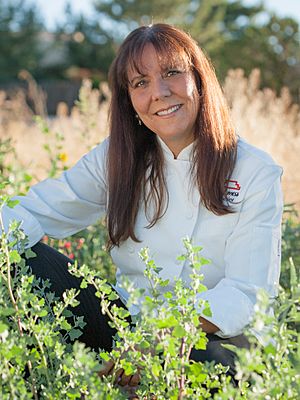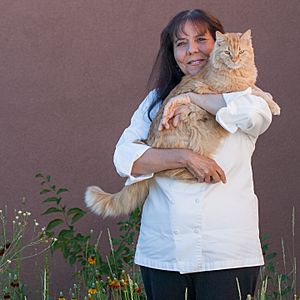Lois Ellen Frank facts for kids
Quick facts for kids
Lois Ellen Frank
|
|
|---|---|

Frank in 2019
|
|
| Born | 1960/1961 (age 64–65) New York City, US
|
| Nationality | American |
| Occupation | Food historian, author, educator |
|
Notable work
|
Foods of the Southwest Indian Nations |
| Awards | 2003 James Beard Foundation Award |
Lois Ellen Frank is an American expert who studies food history. She writes cookbooks, teaches about food, and explores how different cultures use food. In 2003, she won a special award called the James Beard Foundation Award for her cookbook, Foods of the Southwest Indian Nations. This was the first time a cookbook about Native American cuisine won such an important award.
Contents
Early Life and Family
Lois Ellen Frank was born in New York City. Her father was from a Sephardic Jewish family. Her mother, Jeanne Allen West Frank Richman, was from the Kiowa nation.
Her grandmother on her mother's side, Marjorie Rose Keufner, worked as a financial secretary. Her grandfather on her mother's side was James Allen West.
Frank's grandmother on her father's side, Elizabeth Barazani Frank, came from a Sephardic family. This family had left Spain during the Spanish Inquisition. They settled in Ottoman Turkey, then moved to Palestine (region), and finally came to New York City in 1915 through Ellis Island.
Education and Learning
Frank first went to culinary school to learn how to cook. After that, she studied photography at the Brooks Institute and graduated in 1985.
She later earned a master's degree in cultural anthropology in 1999. Her main project for this degree looked at how different indigenous peoples across the Americas used corn.
She then earned her PhD in cultural anthropology from the University of New Mexico. Her big research project was about "The Discourse and Practice of Native American Cuisine: Native American Chefs and Native American Cooks in Contemporary Southwest Kitchens." This explored how Native American food is talked about and made today.
Career and Work
While in college, Frank worked as a cook at the first Good Earth restaurant. After finishing her photography degree, she worked in advertising. She took pictures for commercials for companies like Evian and Taco Bell.
A mentor, Ernst Haas, encouraged her to think about her heritage. Frank realized she was making unhealthy food look good. She decided to explore Native American cuisine. In the 1980s, people told her that "there was no such thing" as Native American cuisine. But she knew it was "intricate, diverse and delicious." Around this time, she met Juanita Tiger Kavena, who wrote Hopi Cookery (1980), one of the first cookbooks by a Native American cook.
In 1991, she suggested writing a book about Native American food to publishers in New York. They told her that Native people "didn't have a cuisine." They also said she "didn't have the credentials" to write such a book. So, she went back to school to earn her master's and doctorate degrees. She remembers that at the time, schools often overlooked the food traditions of Native kitchens.
Foods of the Southwest Indian Nations
Frank talked to people and collected recipes from the Hopi, Ute, Pueblo, and other Southwestern tribes. In 2002, her cookbook Foods of the Southwest Indian Nations was published. She worked on it with Walter Whitewater (Diné).
In 2003, the book won a James Beard Foundation Award. This was a very important moment because it was the first time a cookbook on Native American cuisine won this award. CNN called it "the first Native American cookbook to turn the heads of James Beard Foundation Award judges."
Other Projects
In 2017, Frank was featured in a TV show called Native American Food Movements. This show was about traditional diets.
She also works as a Culinary Ambassador Diplomat for the United States Department of State. She travels with Walter Whitewater to different countries. They have visited Ukraine (2013), the United Kingdom (2015), and Russia (2016). They teach people about Native American food traditions.
Teaching and Consulting
Frank is a professor at the Institute of American Indian Arts in Santa Fe, New Mexico. She teaches classes like Traditional Arts and Ecology, and Ethnobotany of Foods and Plants of the Southwest. She also teaches about Native American cuisine at the Santa Fe School of Cooking.
She works with the Physicians Committee for Responsible Medicine on issues like Native American diet and diabetes. She is also a Certified Lifestyle Coach for the National Diabetes Prevention Program. She advises the Cultural Conservancy on Native American foodways.
With her business partner Walter Whitewater, she started Red Mesa Cuisine. This company offers catering and educational programs. They specialize in traditional Native American cuisine.
Food Philosophy
Frank explains that Native American cuisine has gone through four main periods.
- Pre-Contact Period: This was before 1492. Native Americans used ingredients they grew, gathered, or hunted in their local areas.
- First Contact Period: This began when Europeans arrived. New ingredients, like Eurasian domesticated animals, were added to Native American diets.
- Government Issue Period: During this time, many Native Americans were moved from their lands. They were given government food like flour, sugar, and lard. This led to foods like frybread. Frank calls frybread "a very complicated food." She says it "represents survival" because ancestors might have starved without it. For some, it is a comfort food. For others, it represents a difficult time in history.
- New Native American Period: This is the current time. Native American chefs are returning to the ingredients and recipes from the Pre-Contact period.
"Magic Eight" Ingredients
Frank calls potatoes, tomatoes, corn, beans, squash, chili, cacao, and vanilla the "magic eight" ingredients. These foods were only found in the Americas before 1492. They were then taken to the Old World through the Columbian exchange. This greatly changed the food in those places.
She explains that if these foods were not native to the Americas:
- Italians would not have tomatoes.
- The Irish would not have potatoes.
- Half of the British national dish, Fish and Chips, would not exist.
- Russians would not have potatoes, or vodka made from potatoes.
- There would be no chiles in Asian or East Indian dishes, including curries.
- The French would not have desserts using vanilla or chocolate.
Frank believes it is okay for others to cook Native American cuisine. She thinks it is good if Native American producers, like wild rice harvesters, benefit from it.
Her recipes often focus on vegetables. She prefers to create menus using foods from the Pre-Contact and First Contact periods. She believes foods from the Government Issue period caused health problems, like high rates of diabetes. Because of this, she tries not to use them often.
Personal Life
Lois Ellen Frank lives in Santa Fe, New Mexico.


